Discoid Meniscus
The medial meniscus is on the inside of the knee, it is attached to the ligaments on the inside of the knee (MCL) and the joint capsule. As it is more firmly attached to the deep structures of the knee, it is more commonly injured than the lateral meniscus. It takes approximately 50% of the weight across the medial (inside) compartment of the knee. The lateral meniscus is on the outside of the knee, it is more mobile and ‘C’ shaped than the medial meniscus. It takes up to 80% of the weight across the outside compartment fo the knee.
The medial meniscus is on the inside of the knee, it is attached to the ligaments on the inside of the knee (MCL) and the joint capsule. As it is more firmly attached to the deep structures of the knee, it is more commonly injured than the lateral meniscus. It takes approximately 50% of the weight across the medial (inside) compartment of the knee. The lateral meniscus is on the outside of the knee, it is more mobile and ‘C’ shaped than the medial meniscus. It takes up to 80% of the weight across the outside compartment fo the knee.
In cross section the meniscus looks like a triangle – with the apex (tip) on the inside and the base on the outside. The two parts of the meniscus form a ‘bow tie’ on an MRI scan.
There can be variations of the natural anatomy which can cause the meniscus to tear – a “Discoid” Meniscus. This is where the meniscus develops into a semicircular shape, rather than a crescent shape. It lacks the stability of a normal meniscus, and consequently can tear more easily.
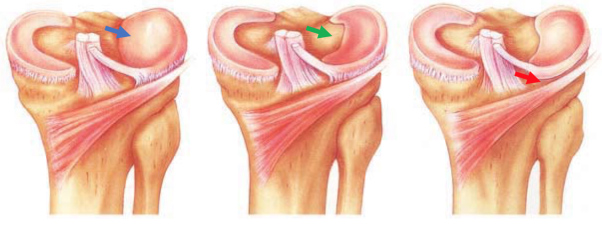
Types of Discoid Meniscus: Complete(Blue Arrow), Incomplete (Green Arrow) and Wrisberg Variant (Red Arrow)
CAUSES
The cause of a discoid meniscus is unknown. Proposed causes are due to a failure during embryological development, or that it is due to a lack of fixation to the tibia.
SYMPTOMS
The symptoms of a discoid meniscus are highly variable. In some cases they may not have any symptoms at all, in the worst cases they can cause significant pain, swelling, discomfort and can cause the knee to ‘lock’ (get stuck and unable to move).
Commonly in young children, parents may notice a non-painful popping or clicking in the knee. In older children/adolescents they may feel as though the knee gives way, or if the meniscus has torn, they may have pain and swelling.
INVESTIGATIONS
Initial X rays can often be reported as normal, as the signs on X ray are quite subtle.
On MRI, the charactertic finding is a “bow tie” sign present on multiple slices.
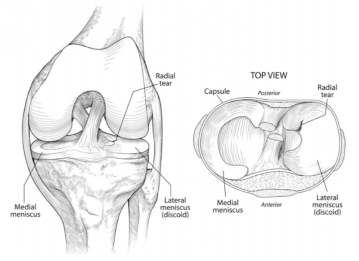
In many cases discoid menisci can be monitored and observed. If they are causing problems, such as pain, locking or giving way, then they may require surgical management.
If the meniscus is torn, it may require surgical excision as frequently the part which has torn off is degenerated and not repairable. In cases where the meniscus is unstable, it may require repair and stabilisation to the joint capsule.
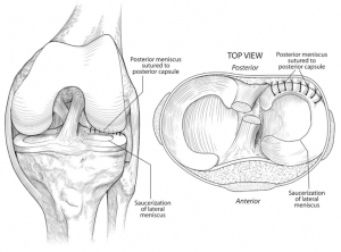
Above: Meniscal stabilisation to the joint capsule.
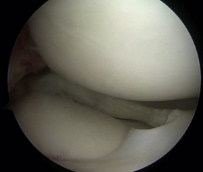
Above: Meniscal resection (saucerisation)
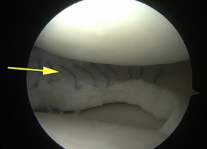
Above: Meniscal Stabilisation (yellow arrow)

